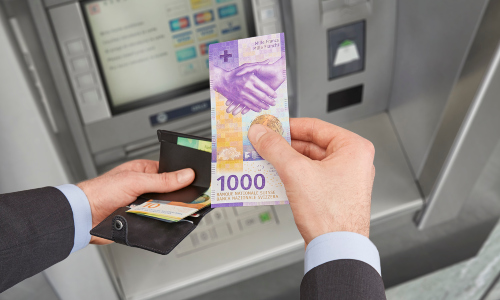SNB Vice-Chairman Makes the Case for Cash
In a time when cash usage is dwindling and big banknotes are increasingly falling into disrepute, one central bank is steadfast. The Swiss National Bank makes a case for cash.
Digitalization has changed payment habits and put pressure on hard cash. Nevertheless, «it is important that cash continues to be widely accepted and easily accessible», said Swiss National Bank (SNB) Vice-Chairman Martin Schlegel in remarks prepared for delivery at the Forum for Financial Market Stability in Liechtenstein yesterday.
The use of cash declined considerably between 2017 and 2020. Approximately 70 percent of all transactions were settled with cash in 2017, falling to 43 percent in 2020, according to SNB surveys. This is a trend that is likely to continue, with the majority of survey respondents anticipating using cash less frequently.
Good versus Evil
One argument for cash is that it allows people anonymity when making their purchases. It also serves as a store of value, which the SNB says is used to a «considerable degree.»
Detractors argue the widespread use of cash has more sinister purposes, such as funding criminal activity, money laundering, and terrorism, not to mention also using it as a store of value resulting from the proceeds of illicit enterprises.
For reasons like this, other central banks have largely done away with large-denomination banknotes. For example, the Monetary Authority of Singapore prohibited the circulation of S$10,000 notes starting in October 2014 and instructed any bank that possessed such notes to not recirculate them. Brunei had a BN$10,000 (value: $7,263) banknote which it withdrew from circulation in November of 2020, also as part of an anti-money laundering campaign.
Large Denominations
Asian countries are not alone in removing large denomination notes. A G7 country has also since followed suit. In May 2020, the Bank of Canada stopped issuing CA$ 1,000 (value: $716) notes and began to remove them from circulation as part of its campaign to fight money laundering and organized crime.
The Royal Canadian Mounted Police (RCMP) known as «Mounties» was one of the law enforcement agencies involved in the decision. According to popular myth, the «Mountie always gets his man,» i.e. criminal. Perhaps that helped the RCMP to nab some nefarious money launderers.
According to the Bank of Canada, there were around 3.8 million CA$1,000 banknotes in circulation in 1999, making up about 0.3 percent of the total in circulation. Certainly not a big part of its money stock, but the denomination was enough of an issue to cause the BoC to take the measures it did.
Under the Mattress
The 500 euro note has not been printed since 2014 and was no longer put into circulation by central banks since 2019. However, it is still possible to exchange them at the central banks. Its share of cash in circulation in the eurozone is just under 11 percent, although is more likely to be hiding under mattresses than used as a means of payment.
1,000 Swiss Franc Notes
By contrast, 1,000 Swiss franc notes (worth $1,057) made up 9.4 percent of banknotes in circulation during 2021 valued at around 50 billion francs, according to the SNB. The most widely circulated currency is the 100 franc note, making up around 28 percent of circulated cash with a value of 14.8 billion francs.

(Image: SNB)
Those figures indicate that cash is still a very much favored vehicle for transactions in Switzerland, where no one bats an eye if a 100 franc note is tendered to pay for even a small purchase. Contrast that to places like the US, where settling a bill with a $50 or $100 note is likely to earn you a suspicious look.
Declining Cash in Circulation
Schlegel says the SNB has «no preference» as to whether a person pays with cash or some form of cashless method. Yet he goes out of his way to stress the importance of cash, saying there are «risks in a strong shift towards cashless payment methods. Declining cash usage puts economic pressure on the cash infrastructure.»
Cash can be used when there are technical issues with a mobile phone or a payment network, cash serves as a particularly good backup, but for that to work, it must be readily available and widely accepted. Schlegel then takes his audience on the trip a 20 franc note takes from printing to finding its way into one of 6,500 ATMs around Switzerland, about one per 1,300 inhabitants. Typically one will find an ATM within one-kilometer proximity.
Shrinking ATM Network
Even so, the number of ATMs has declined in recent years. Schlegel points out that the supply and processing of cash is a volume business, with an expensive infrastructure needed regardless of how many banknotes are produced. So the less that is withdrawn, the higher the costs, with the possible result of the network being thinned out.
«A reduction in access and declining acceptance could therefore start a downward spiral, with more restricted access, less use, and more limited acceptance mutually reinforcing each other,» Schlegel warns.
Don't Take Cash for Granted
While the use of cash is declining, it has important properties that other methods cannot match.
«The freedom of choice people now have when it comes to making payments is of great importance to them, and therefore also to the SNB. However, this freedom is not to be taken for granted, and hinges on the smooth functioning of the day-to-day supply and distribution of cash,» he concluded.
At the Swiss National Bank, cash is still king.






































